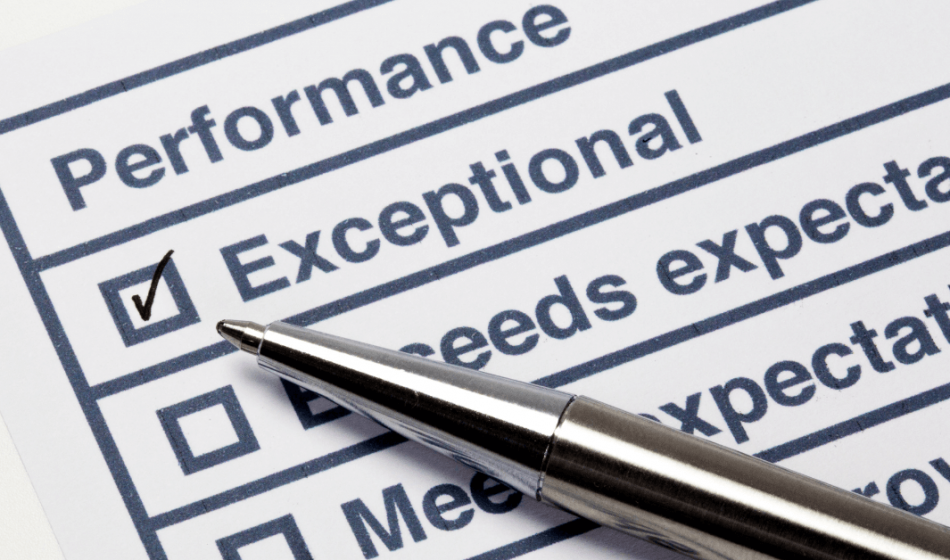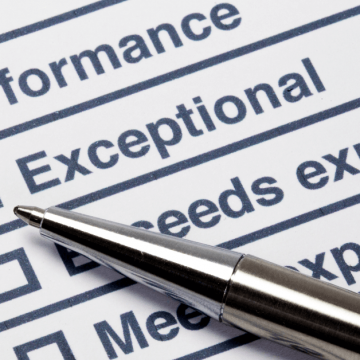

Answering the Top 3 FAQs on Performance Evaluations
Performance evaluations and annual reviews can often be a stressful endeavor for both supervisors and employees alike.
In our practice, we receive a range of questions from how frequently performance evaluations should take place, to what questions to ask. In this article, we’re answering some of the questions we hear most frequently.
Q: How often should I meet with my employees to evaluate their performance?
At Mahoney Performance Institute, we believe that more frequent, less formal touchpoints are key to maintaining healthy communication and productivity on your team.
With traditional annual reviews only, it can be extremely difficult to think back on an entire year to compile feedback and recognize accomplishments. Not only that, but only reviewing progress against expectations once a year can limit employees’ growth.
Instead, try creating a routine to meet quarterly or bi-annually to share more timely and meaningful feedback. This will not only be less imposing on time and allow for more timely and continuous improvement, but will also provide you with an opportunity to make meaningful changes as a leader, too. This practice will also allow you to use the accumulation of data compiled from your meetings throughout the year to have more meaningful and informed conversations about promotions and salary increases.
Q: Sometimes the conversation can feel awkward or forced. What are your tips for making it feel more natural?
The key is to remember that the evaluations are intended to serve higher performance and improved working relationships and that feedback can go both ways.
Traditionally, performance evaluations are used to discuss an employee’s growth and areas for improvement. But rarely does the feedback ever go the other way and focus on the supervisor.
We’ve seen great value in encouraging a two-way conversation between employees and supervisors. To do this successfully, it’s important that both participants come in prepared for the conversation.
Start by setting the tone and demonstrating that the conversation is important to you. Be present and ready for the conversation and avoid checking your phone or computer during the conversation.
If you get the sense that the employee is nervous, try shifting the focus to you as their supervisor first. You can do this by sharing something positive or recognizing their positive contributions.
Throughout the conversation, consider asking the employee to share what you should start, stop and accelerate doing to help foster candid feedback on how you are doing leading them. Here, you would ask for feedback from your employee to help improve your leadership practice and learn from them what they need from you to be more effective and impactful.
In having these conversations, it’s important that your organization’s culture reinforces the value of this exchange. When performance evaluations are performed just to check a box, the feedback will not be as useful. Leaders have to be vulnerable, and not get defensive when their team shares their feedback. Remember, it’s all in service of the whole team doing better together.
Q: How should I prepare for performance evaluations?
During performance evaluations, it’s important for you as the supervisor to clarify and define priorities – this takes work upfront but makes life much easier going forward. Set expectations ahead of time so your employees know what the conversation will be like.
A few quick tips to consider when preparing for your performance evaluations:
1. Create a consistent framework
Performance evaluations can feel stressful for some employees. By creating a two-way conversation and letting your team know ahead of time how they’ll be measured, you’ll have more meaningful and productive conversations.
When working with our clients, we advise they use a framework for conversation and share the framework with their employees ahead of time. An example of a successful framework for more frequent performance conversations is to simplify a focus around the following four areas:
- Progress against expectations; accomplishments and disappointments
- Plan for the next 90 days; what is the focus for next period
- Areas for improvement; specific and how to measure success
- What’s needed from the supervisor to serve the employee better
Remember, the goal is to gain employees’ perspectives and for you to share yours. And by opening up the conversation to accept feedback about your performance as a supervisor (using the start, stop, accelerate exercise works well for this), you’ll gain insight on how you can improve your leadership and how your organization can improve its practices.
2. Reinforce your culture
Think about how you can use performance evaluations as an opportunity to reinforce your organization’s culture. An easy way to do this is by evaluating employees both on their performance in their role, and how they are performing against your organization’s values and mission.
Specifically refer to instances in which they lived the values and beliefs of your organization. In this reflection, you should also point out areas for growth.
When talking about areas of improvement, always look for opportunities to coach your employees. You can do this by sharing real-life examples and committing to them that you will help them to achieve the goal discussed.
3. Consider using ratings to elicit richer conversations
Consider using a numerical system (1-5, 1-10, or +, – and =) to assess performance across specific development areas or expectations. For numerical ratings systems to work well, the expected performance must be clearly conveyed and understood. Once you have established a rating for a given performance area, foster a conversation about why the rating was applied and what specific things could be done to improve the rating. Or, if their rating was very high, share what specific actions, results or behaviors led you to rate so highly. This approach can lead to richer conversations regarding on-going performance.
However, if you do use a ratings system, be careful about making them the centerpiece of the process. A good tip for this is to use ratings to do your preparation to help guide your thinking without directly incorporating them into your conversation. Without proper context, people can see this as “too mechanical” and may not thrive in this environment.
Additional Resources
If you’re interested in learning more about how you can improve your practice of performance evaluations, here are two additional resources for you to explore.
Book: The Essential HR Handbook, by Sharon Armstrong and Barbara Mitchell
This book is a quick and handy resource for any manager. It contains an abundance of practical guidelines, tips and tools for managing our most important resource; our people. Don’t let the title fool you. This book is very useful for all types of leaders and not just HR professionals. There is a chapter in this book focused on best practices, tools and tips for planning for and leading effective performance evaluations and reviews.
Article: The Performance Management Revolution; from Harvard Business Review’s 10 Must Reads for 2018, by Peter Cappelli and Anna Tavis
This article is an insightful view of very different thinking about performance management. The authors share how many organizations are struggling with their own performance management systems and looking for alternatives that add value to both the employees and the organization. They assert that traditional performance systems place too high an emphasis on financial rewards and punishments through their end-of-year structure. They hold people accountable for past behavior at the expense of improving current performance and grooming talent for the future, both of which are critical for organizations’ long-term survival.
In contrast, regular conversations about performance and development change the focus to building the workforce your organization needs to be competitive both today and years from now. Business researcher Josh Bersin estimates that about 70% of multinational companies are moving toward this model, even if they haven’t arrived quite yet.
The key to all of this is remembering that it will get easier and better over time. Putting in the work to meet more frequently or have more productive, thoughtful conversations might feel like a lot now, but over the course of time it will become a straight-forward and meaningful routine. Plus, when your employees see that you care and are open to feedback, you’ll start to learn how you yourself can improve your performance as a leader.
